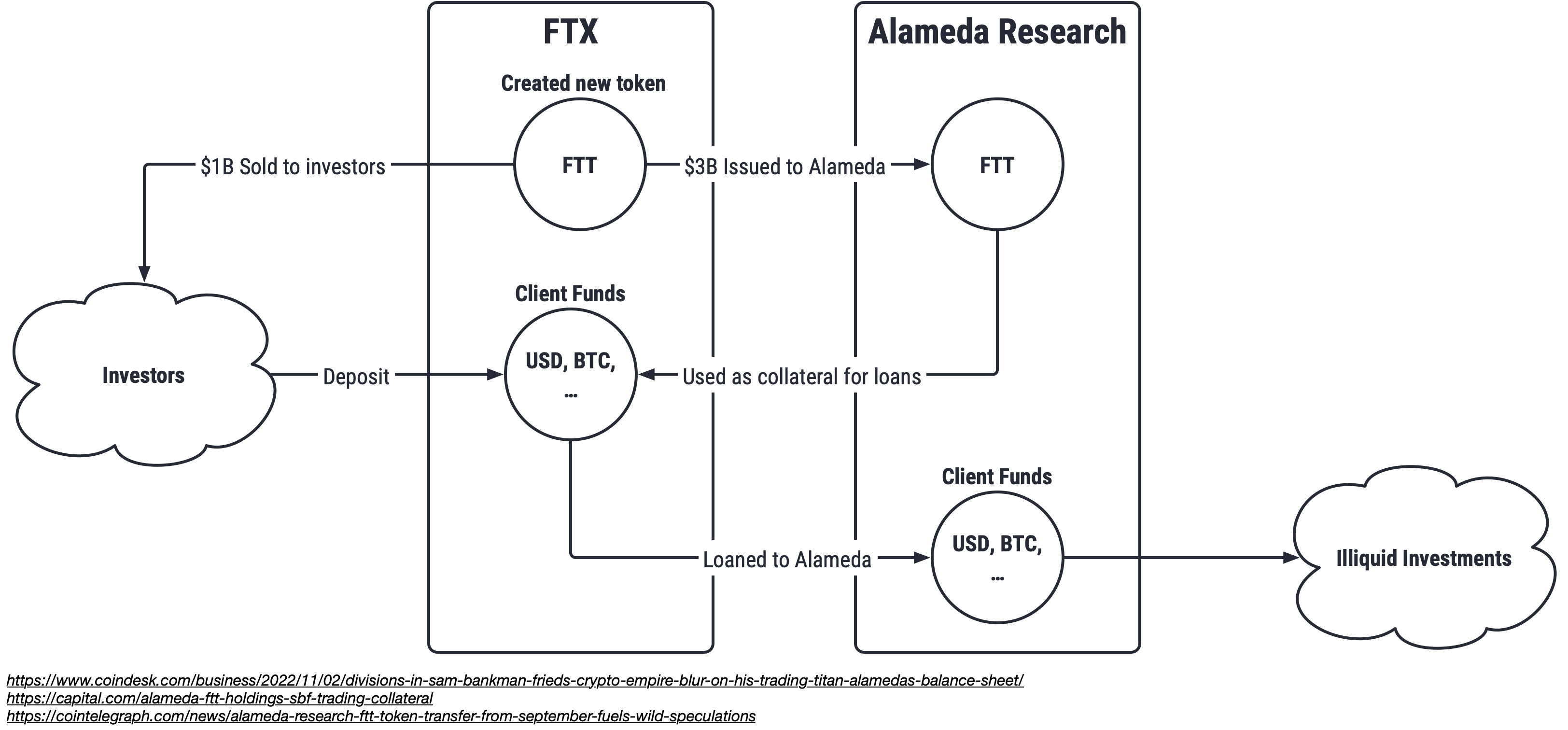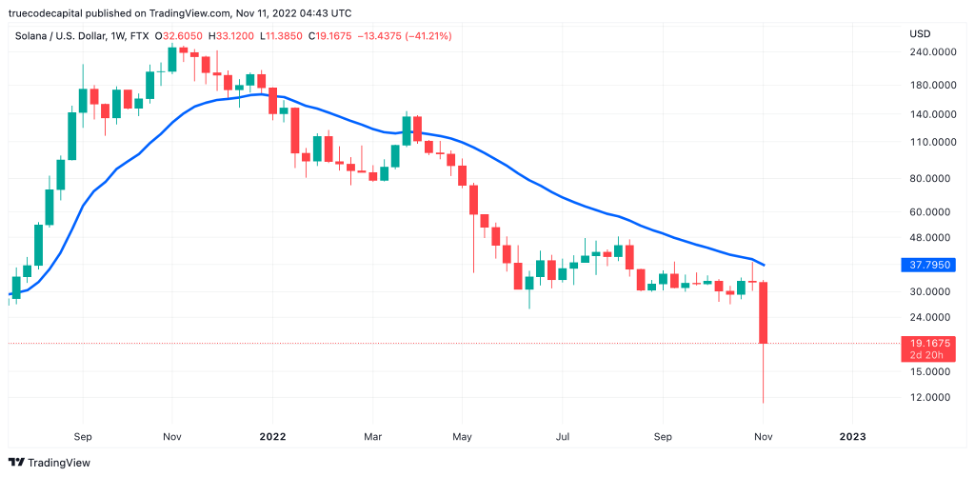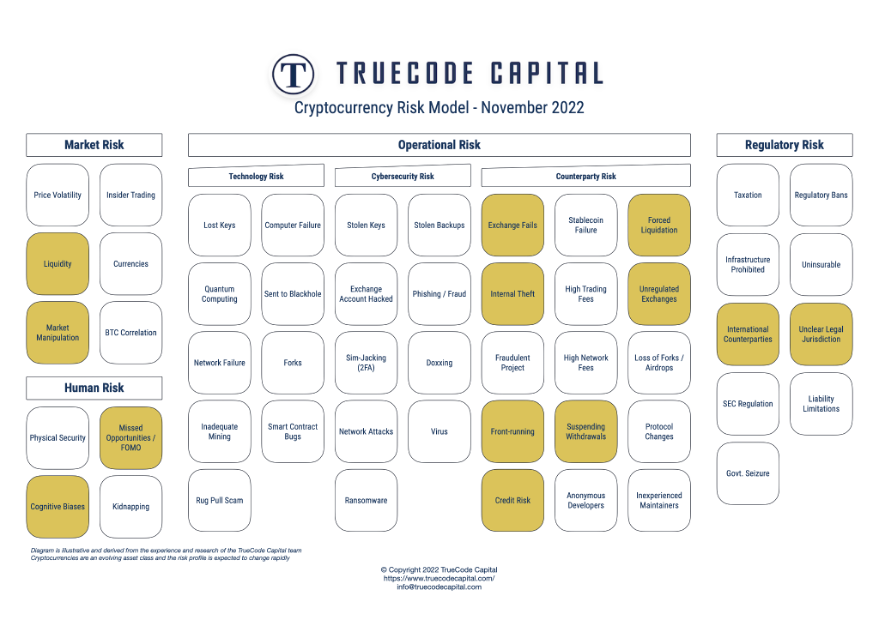This week FTX, the third-largest cryptocurrency exchange in the world suspended withdrawals1 due to lack of liquidity. This stunned the investor community and made headline news throughout the world. This would be equivalent to Bank of America suspending access to customer funds in the traditional financial world.
Details were murky early on, but it is becoming clearer that Sam Bankman-Fried improperly commingled assets between his hedge fund, Alameda Research, and the cryptocurrency exchange he founded, FTX. As recently as January 2022, FTX was valued at $32 billion2 and Sam Bankman-Fried was hailed as the next great innovator. The firm went on a buying spree, sponsoring a stadium and rescuing its failing peers during the Crypto Contagion sparked by the Terra / LUNA failure and culminating in the failure of Three Arrows Capital (3AC) and Voyager.
Ultimately, FTX failed because inexperienced founders blurred the lines between their and their clients’ accounts.
Run on the Crypto Bank: FTX and Alameda Research
The relationship between FTX and Alameda Research appears to be inappropriate in many ways. First, FTX was founded to help route orders for Alameda Research. A common arrangement made suspicious by the fact that Alameda Research specializes in arbitrage, so there has always been some concern about the fairness of order routing on FTX.3 Were client orders being front-run because of this close relationship?
Now we know that it was much worse. Whether client’s orders were being routed fairly or not, client funds were being moved between the entities in ways that are shocking.
In 2020, FTX minted a new token, FTT. A large portion of this token was issued or purchased by Alameda Research and a much smaller amount was sold to the public. This created a scenario where Alameda was able to us the public price of the token to collateralize loans to FTX in exchange for client funds4,5,6.

Figure 1: FTX and Alameda Research Diagram
This scheme worked as long as the value of the FTT token continued to increase and few investors chose to redeem it, however when the price of FTT began to fall, the loans of client funds to Alameda became uncollateralized. This was exacerbated by the fact that Alameda Research used those funds to make illiquid investments in venture capital, private equity, and certain locked DeFi projects so that of their $8 billion balance sheet, less than $500 million was liquid.7
Rival crypto exchange Binance chose to liquidate their $500 million in FTT holdings, which forced FTX into a liquidity crunch.8 As the price of FTT dropped, the collateralization of client funds diminished because the loans of client funds were collateralized by FTT on the Alameda Research balance sheet and invested in illiquid investments.
FTX was forced to cease withdrawals because they did not have enough assets to service them after nearly $6 billion of assets were withdrawn from their platform.9
Lessons Learned
Leverage Kills
If FTX had operated a full-reserve cryptocurrency exchange, simply collecting fees for client trading, they would have collected nearly $10 million per day. However, by issuing a token of questionable value, leveraging client funds, and investing them in illiquid investments, they created a doom loop that got out of control and destroyed the firm.
This is a recurring theme in crypto failures from Bitconnect to Celsius Network to FTX where investors and firms try to improve upon a great investment and take tremendous risks for limited benefits.
Offshore Crypto Exchanges are Dangerous
Many FTX investors are learning a hard lesson about investing offshore. There are fewer legal protections outside the US and rule of law can be complicated when litigating internationally. While the federal regulatory framework for crypto exchanges remains nascent, US-based exchanges benefit from state-imposed regulatory frameworks that help protect investors.
The benefit of having clear rule of law regarding your claims against a firm cannot be overstated.
Crypto Lending Schemes Usually Fail
Crypto lending seems to be a doomed product. Nearly every firm that has tried it has failed. Investors continue to seek out additional yield on their crypto investments without consideration for how those yields are achieved. For a firm to offer yield on crypto, they must lend the tokens out to another party or invest them to create that yield.
This has consistently failed in practice as firms compete by offering the highest APR and undertake riskier and riskier investments to be competitive.
Cryptocurrencies are bearer assets, lend them at your own peril.
Risk Premium is not Risk-Free Return
To further complicate matters, many offshore hedge funds are incorporated outside the US not only to attract extra-US capital, but also to access FTX and other unregulated exchanges. Investors who were promised a risk-free return through market-neutral strategies may see a total loss of principal once the dust settles.
There are few pure arbitrage opportunities. When price discrepancies occur between exchanges operating in different countries, it is often due to political risk. When price discrepancies occur between two exchanges making a market on the same token, it’s frequently because the liquidity or trading fees are different between the exchanges.
More commonly, investors believe they have a risk-free return while actually receiving a risk premium due to a small risk of total loss as the FTX failure illustrates.
Crypto Markets are Adversarial
The design of Bitcoin and most cryptocurrencies is different from the traditional financial system. These technologies were designed to operate in an adversarial environment. Bitcoin assumes the value represented by its tokens will be desirable to thieves, so incorporates high quality cryptography to protect that value. This approach has been wildly successful and no coins have been stolen by breaking the cryptography to date.
Any assumption investors have of crypto markets operating in a collaborative environment is misplaced. Crypto networks with limited participants are not as secure as those with many participants and investors should expect them to be attacked regularly. Only through these repeated attacks can you have confidence that the cryptocurrency project is secure and reliable.
When Binance sold their FTT holdings and exposed a liquidity shortfall on FTXs balance sheet, they may have been the catalyst, but the failure of FTX was inevitable.
Experience Trumps Media Popularity
It appears the team at FTX may have been so inexperienced that they didn’t realize the scope of the problem they created. Sam Bankman-Fried has reportedly suffered a 94% decrease in net worth as part of this event buttressing his claims of sincerity. Most likely, these highly educated, extremely intelligent people trusted complicated financial models.
This is typical of inexperienced investors who have only experienced up-trending markets and believe textbook financial models are applicable to markets. Seasoned investors, especially experienced crypto investors, are distrustful of the asset class and go to great lengths to reduce the risk they are exposed to.
Every financial model, every smart contract, every financial product should come with a disclaimer stating: “if everything works the way we think.” This is a lesson that only experience can teach.
What Happens Next?
FTX Clients Lose Everything
The $8 billion invested at FTX is likely lost to investors. While there may be some claim through the bankruptcy process, it is exceedingly rare for an exchange to re-enable withdrawals after a major event such as this. Even if withdrawals were resumed, the rush to remove assets from the platform would likely create further liquidity problems and crash the website.
At the moment all FTX assets have been frozen10, which is common in this scenario so regulators can unwind the remaining assets in an orderly fashion during the likely bankruptcy. If the Mt. Gox bankruptcy is any indicator, the process could take a decade or more while the bankruptcy process determines what assets remain and who owns them.
For the moment, all balances on FTX are illiquid, so virtually valueless.
Alameda Research Portfolio may be Valuable
Because the FTX & Alameda Research debacle seems to be a matter of inexperience than outright theft, it’s likely that the investments held by Alameda may be more valuable in the future than they are today. Once the dust settles, these assets may be substantial enough to make all the FTX clients whole.
During the Mt. Gox bankruptcy a number of firms chose to purchase the claims of investors who were part of the bankruptcy suit at a discount, but investors were able to reclaim a fraction of their investment much earlier.
Bankruptcy May Take a Decade or More
As with the Mt. Gox11 bankruptcy in 2014, there will be many parties in many geographic locations with claims on the remaining assets, so the bankruptcy will likely take many years to resolve. This will be a complicated case with thousands of parties involved. I have personally met several people who lost money in the FTX failure in the past 24 hours. It cannot be overstated how many people were affected by this failure.
All of those participants must be given an opportunity to participate in the claims against the remaining FTX assets and that will take time.
Patient Investors May Still Make Money
FTX investors focused on high-quality tokens such as Bitcoin and Ethereum who are patient enough to allow the bankruptcy process to unfold may still make money. Assuming the bankruptcy takes several years and a significant fraction of their original investment is returned, investors could still be made whole. They will, of course, incur an enormous opportunity cost in the intervening years, but nonetheless their claim on assets may prove fruitful.
While investors on the FTX platform may have lost everything, this event creates an opportunity for patient investors with capital to invest. This is the ultimate “blood in the streets” moment of this crypto market cycle, so investors who are thoughtful about their investment philosophy may find opportunity in this market. The market decline from the FTX failure creates an opportunity to accumulate crypto assets at prices many may find desirable.
Threats to Solana
It’s likely that anything associated with Sam Bankman-Fried will suffer in the aftermath of this event. Bankman-Fried was so influential in the crypto industry before the failure of his firm that a number of projects became known as Sam’s Coins because of his influence. Included in Sam’s Coins is Solana, the so-called Ethereum Killer, where 10% of the token is owned by Alameda Research. Those coins will be sold at some point in the bankruptcy process, which could drive the price further down. In fact, Solana was amongst the hardest hit once the news of FTX’ liquidity was announced, plummeting 65% this week for a total decline of 95% during this bear market.

Figure 2: Solana Weekly Chart – TradingView.com
How to Protect Yourself?
Understand the Crypto Risk Profile
At TrueCode Capital, we are obsessive about crypto risk. We believe that the key to prospering in crypto investing is to survive events like those that have occurred this year with FTX, Celsius, Voyager, Three Arrows Capital or the long list of other firms that have been forgotten over the past decade.
Our approach includes an expansive view of the potential risks of crypto investing ranging from Technology Risks like losing wallet keys to Counterparty Risks like an exchange failure.
Personally, I have made it my mission to help investors discover their blind spots when investing in cryptocurrencies and I have written a book, Cryptocurrency Risk Management: A Guide for Family Wealth Managers, that dives deeper into the topic.
Register to be informed when the book is released (expected Jan 2023):
Cryptocurrency Risk Management: A Guide for Family Wealth
I have also developed a Cryptocurrency Risk Model that helps investors better understand the broad spectrum of risks to the crypto asset class. Below I have highlighted the specific areas of risk breakdown for the FTX failure.

Figure 3: Cryptocurrency Risk Model with FTX Failures Highlighted
Download a copy of this risk model at: Cryptocurrency Risk Model
Use High Quality Exchanges in Knowable Jurisdictions
Working with cryptocurrency exchanges in the US or other major western nations offer a number of benefits to investors. Not only is the rule of law more knowable, they are often more professionally operated, offer greater liquidity, better insurance, and reduced risk of total loss.
Many firms are achieving their SOC 2 compliance, which is not a guarantee of high-quality internal controls, but signifies a serious effort by the firm to have high quality cybersecurity processes.
Even with a good quality exchange in a great jurisdiction, problems with exchanges can still happen. There are many high-quality exchanges around the world, investors have the option to partition their assets amongst these exchanges to further reduce the risk of total loss.
Invest in High Quality Tokens and Avoid Leverage and Derivatives
It’s virtually impossible to use derivatives without some leverage and in the emerging cryptocurrency industry, the leverage facilities are immature and unreliable. Many investors have found out the hard way that their market neutral strategy isn’t actually neutral when one side of the contract fails to honor their commitment.
However, the returns from native tokens such as Bitcoin, Ethereum, and Cardano are still desirable to many investors. Assets that have sold off by 75-98% creates an opportunity for investors to acquire tokens for high quality projects at desirable prices.
But it doesn’t matter how cheap a coin is if the price never increases in the future. Experience suggests that many of the coins popular today will never recover, but some will and investors who are thoughtful about portfolio construction and avoid the lure of excess profits accompanied by excess risk can prosper.
Footnotes
- 1 https://www.reuters.com/business/finance/crypto-exchange-ftx-saw-6-bln-withdrawals-72-hours-ceo-message-staff-2022-11-08/
- 2https://www.reuters.com/markets/currencies/rise-fall-crypto-exchange-ftx-2022-11-10/
- 3https://www.bloomberg.com/news/articles/2022-09-14/trading-firm-alameda-research-powers-ftx-ceo-sam-bankman-fried-s-crypto-empire
- 4https://www.coindesk.com/business/2022/11/02/divisions-in-sam-bankman-frieds-crypto-empire-blur-on-his-trading-titan-alamedas-balance-sheet/
- 5https://capital.com/alameda-ftt-holdings-sbf-trading-collateral
- 6https://cointelegraph.com/news/alameda-research-ftt-token-transfer-from-september-fuels-wild-speculations
- 7https://www.bloomberg.com/news/articles/2022-07-14/celsius-bankruptcy-filing-shows-long-reach-of-sam-bankman-fried
- 8https://www.reuters.com/markets/deals/binance-acquire-ftx-unit-help-with-liquidity-crunch-ceo-2022-11-08/
- 9https://www.reuters.com/business/finance/crypto-exchange-ftx-saw-6-bln-withdrawals-72-hours-ceo-message-staff-2022-11-08/
- 10https://www.wsj.com/articles/ftx-digital-markets-assets-frozen-in-the-bahamas-11668123467
- 11https://www.bloomberg.com/news/articles/2014-02-28/mt-gox-exchange-files-for-bankruptcy#xj4y7vzkg
- 12https://news.bitcoin.com/since-2014-roughly-42-of-failed-crypto-exchanges-have-disappeared-without-a-trace-for-no-apparent-reason/



